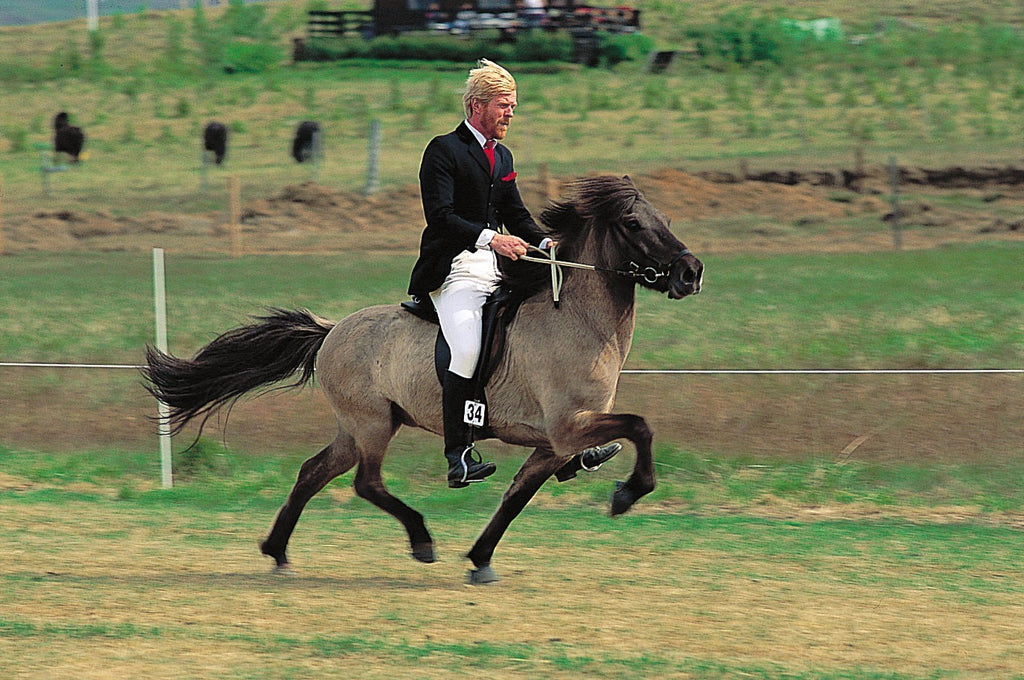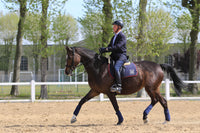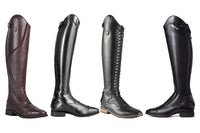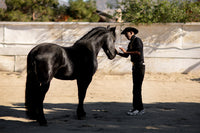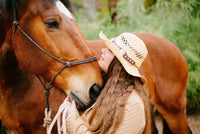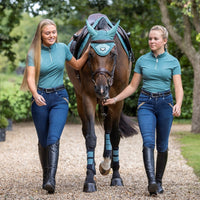What makes excellent dressage of a horse? Well, the best dressage depends on several objectives and exercises that we must carry out. One of these objectives is accepting the neck's gulp and transfer (flexion) from the preliminary phase of its dressage. Today, we will discuss the use of various types of horse reins, running martingale, and of course, breastplates that are generally used for this purpose.
From the outset, Horse reins, Martingale & breastplates act as supporting elements. In some instances, with a new rider or a wrong horse, the Horse reins could be of great help.
Types of horse reins:
To work with horse reins is carried out both standing and mounted. The most common groundwork is the side reins, the running martingale, the Martingale horse and the breastplates. For mounted work, the following are used: the side reins, the ring martingale and the fixed martingale.
Side reins:
They are two adjustable straps, lateral and independent from each other. On the one hand, they are fastened to the ring or the saddle and, on the other, to the fillet. Some highly recommended side reins have a rubber ring on each strap to soften their action. They are used on the rope, with or without a rider.
Martingale Horse:
The running martingale consists of a cord with a certain degree of elasticity, which goes from the circumference between the horse's forelimbs. It passes through the ring of the fillet, continues along the neck, and returns through the Horse bridles UK towards the circumference. Because it is elastic, it can also be used when the horse makes small jumps on trestles. However, remember that exercises must always start and end without strapping.
The running martingale is a variation with a somewhat more complex strapping. Its action is more direct on the neck of the horse. The best you can find is the Cob martingale.
The breastplates:
This strap system is the only one that tries to integrate the anterior and posterior third of the horse. Therefore, it has different positions to be used depending on the level of training: low, high, and medium. In addition, the breastplates come in one size and can be adjusted for small, medium, and large horses.
German reins:
This type of rein is a variation of the typical harness used in all kinds of riding. It is a much longer rein (5 to 6 meters). This is because, instead of being attached to the ring of the fillet, it passes through it and continues between the legs until it is attached to the girth. The German rein has a powerful effect, and its good use depends a lot on the knowledge and sensitivity of the rider. With this rein, you can easily exaggerate the flexion of the nape, head and neck. Therefore, it should be used by experienced riders/amazons.
Ring Martingale Horse:
The use of this Martingale Horse is widespread in the jumping discipline. Like the other auxiliary reins, its objective is to control that the horse does not raise its face or escape from the hand. It consists of a strap fixed to the chest, which opens in a "Y" with two rings at the ends, through which the rider's rein passes. Its action is maintained as long as the rider has contact with the horse's mouth. When the rider stops tensing, the ring martingale is loosened, and its effect ceases. This is interesting because, unlike the other auxiliary reins, the horse can have complete freedom in moments of recreation. You must check for Pony martingale.
Fixed Martingale:
You can choose a brown martingale with a single strap that runs from the bib to the noseband strap or the ring for a separate harness. If it is placed on the bit chain, it is even stronger due to the action on the horse's mouth.
How to use the horse reins?
All these aids are intended to prevent the horse from raising its head and inverting its neck. Therefore, their use is very delicate because they can produce an opposite effect to the desired one if they are not used correctly.
• Auxiliary reins for horses are intended for the equine to bend its neck, lift its back and come to a stop. When the horse is treading correctly, the auxiliary horse rein should not affect. Therefore, the auxiliary reins mustn't be too short or too tight.
• Horse reins are generally adjustable and should be fixed when the horse's head is in a natural position. That is, these auxiliary reins such as running martingale and breastplates should never force the horse's head to look for an optimal position that we want to see. During the work, the horse will find an upper limit and give its head and neck.
• If they are adjusted too short, the horse will lower its head and give its nape only due to forced retention, and it will not learn to position itself correctly but will always be pulling upwards. In this instinctive reaction situation, his neck can be muscular in the lower part and not in the upper part as is desired.
• The trainer must keep the horse's hindquarters active so that the work is carried out with a good impulse, and the results are seen in the entire body of the horse.
In a work session, the warm-up should start with walking and without the use of horse reins (5-10 minutes), then the running martingale, and if required, the breastplates are placed and worked at a trot (20-30 minutes), finally finishing at a trot and spend removing the reins (5-10 minutes). Work should always switch from one hand to the other.
Why we must not neglect our horse reins
Any of the above elements can be of great help; however, they are only a compliment. For a good positioning of the horse's entire body, nothing replaces the natural aids that we have. The good use of our body to teach the horse to carry us well produces better and faster results. Get Farrier & Chaps/Aprons UK from Equine World
What must we look for?
• A correct seat, on the sit bones and not on the buttocks
• Precise use of our legs, relaxed knees, calves in minimal contact with the horse, acting rhythmically only when necessary
• Correct use of the hands, resisting and never pulling.
• The ultimate goal is for our horse to gradually give its nape, tensing its ligaments through its back and putting its hindquarters under the mass. His profile will look "rounded", and there will be greater comfort for the horse and rider.
Horse Reins: the right way to use them
Horse reins are used in horse training. Their use is very delicate because they can exert very strong pressure on the horse's mouth, head and neck. They were invented by the Duke of Newcastle (UK) in the late 18th century. Now they are known worldwide but unfortunately many times they are left in inexperienced hands and the horses are spoiled instead of being "educated".
Here we will delve into the correct use of this type of reins, what they are for, how to place them, etc.
What are they for
The natural tendency of the horse, when we mount it, is to open its face, sink the back and pull the hindquarters out of the mass. Our role as riders is to reverse that positioning by teaching him to carry us properly so that his body is not affected by our weight.
To achieve this goal, several gadgets have been invented. First, the reins and running martingale is for the rider so that the horse accepts the fillet and its top line looks “round”. Next, face vertically (or a little in front of it), back straight and flexible (supporting the weight with the ligaments and not with the muscles). Here, the bridles are lowered, and the hindquarters are tucked under the mass.
Here two very important conditions are worth mentioning:
When using any of the auxiliary reins, think not only of his head but of his entire body. The leg, seat and hand aids must be fastened considering the "complete" horse. The horse "in hand" with the rounded top line is not the result only of a series of exercises that seek to position the horse with or without auxiliary reins. It results from constant work that first tries to meet the following objectives: ease, flexibility, bodybuilding, impulse, contact, rhythm and balance.
How to set the Breastplates
The breastplates are straps that hook into the circumference. They go through the fillet (from the inside out) and go to the rider's hand. Its approximate length is 2.50 meters each. These plates have a carabineer to attach to the ring of the strap and at the other end the buckle for the union between the two. We recommend the use of leather breastplates with eyebolts for the girth. They are used in conjunction with normal reins attached to the fillet. This creates ease. However, the rider must know how to handle their hands at four reins from Equine World
How to use the reins effectively
All these reins are fixed at a certain point, and the horse's head cannot go beyond that point. The side reins, by contrast, do not have a fixed point. Therefore, the rider/rider's hands must regulate them, letting the neck stretch, maintaining minimal contact with the horse's mouth. For that reason, the horse reins are much more difficult to use to obtain positive results.
The rider/riders must be educated, meeting the following requirements:
Have a great sensitivity to perceive the minimum reaction of the horse.
• Avoid forcing the horse's head into a certain position. Instead, the auxiliary like martingales or breastplates must allow the horse to stretch its neck, look for the fillet, and gently accept the containment of the minimum contact of hands. This is achieved when the horse is fulfilling the objectives previously exposed: looseness, flexibility, etc.
• Do not pull on the rein because the horse can easily get overcast. This brings hardening, inflammation and possible injury to the horse's neck.
• The legs and the saddle of the rider must work together so that the horse, together with his instinct to go forward, reaches the hand with enough momentum.
• When to use the reins
• The reins are used on the track and with basic dressage exercises. However, they should only be used for a time while the horse learns to perform the first steps of lying in hand. Then they are removed.
• Parallel to the proper use of this type of reins, it is very important to review our knowledge regarding the application of legs, seats and hands. From my point of view, there is no auxiliary rein to replace our natural aids.
Tips for using the horse reins well
• The reins must be taken each one in one hand, the elbow, the hand, the rein and the horse's mouth must form a straight line.
• The aids will always be given from the shoulders with the wrists inwards.
• At the raised trot, we will mount with the hand somewhat low, and at the seated trot and a gallop, we will raise the hand to the height of a fist of the cross.
• The hands will be separated by the width of the horse's neck.
• We will use the rein as we need in each case. Remember the five effects of the reins, starting at the beginning of the training with the simplest one. That is, the direct rein, and with the progress of the horse in its training, we will end up doing lateral exercises with the opposition rein.
What are the effects of the reins?
The effects of the reins are simple enough to understand. What is difficult is to acquire the ability to make them to the maximum use. However, we cannot deny that they contribute in a substantial way to the arsenal of serious riders and increase their ability to effectively and gently position your horses.
Remember, the instruction used to give most frequently is intended for the rider to act appropriately without contrasting objectives.
Caution!
The great danger for the novice rider is to think that each rein can be used in isolation. Instead, every rein must be supported effectively by its partner to moderate or increase the share.
When perfection is reached, the effects of the reins melt into a harmonious ride.
Horse reins are only effective when there is a sustained drive, and therefore, they are always subordinated to the action of the legs and the drive they produce.
Did you just search for an Equestrian shop near me? Wait no more! Equine World is one of the leading online Horse shops in the UK for you.

